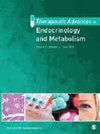高收入亚太地区甲状腺癌症的全球负担:全球疾病负担研究的系统分析
IF 3.9
3区 医学
Q2 ENDOCRINOLOGY & METABOLISM
Therapeutic Advances in Endocrinology and Metabolism
Pub Date : 2022-01-01
DOI:10.1177/20420188221090012
引用次数: 3
摘要
背景:甲状腺癌症日益流行,威胁着人类健康。很少有研究探讨癌症在亚洲的发病率及其与社会进步因素的关系。方法:我们分析了2019年全球疾病负担(GBD)研究中甲状腺癌症特异性数据。使用发病率、患病率、死亡率和伤残调整生命年(DALY)率来评估甲状腺癌症的负担。结果:2019年,全亚洲每100000人口的年龄标准化发病率、患病率和DALY率分别为1.34%(95%UI,2.44–3.07)、2.79%(95%UI、18.82–23.77)和16.49%(95%UI,14.6–18)。2019年,高收入亚太地区的甲状腺癌症DALY率最高,高收入亚洲-太平洋地区的甲状腺癌症死亡率也最高。高收入亚太地区DALY的增长趋势比其他亚洲地区要陡峭得多。在所有亚洲地区和亚太高收入地区,女性患者甲状腺癌症的发病率、患病率、死亡率和DALY率显著高于男性患者。在亚洲癌症患者中,80-89岁男性的DALY率较高 年龄比女性多。DALY发生率随着年龄的增长而逐渐增加。在亚洲太平洋地区,甲状腺癌症患者的死亡率随着年龄的增长而下降。40-79岁人群的患病率最高 年。结论:亚太高收入地区甲状腺癌症的疾病负担明显高于其他地区,这可能是由于过度诊断所致。甲状腺癌症发病率的增加似乎表明,癌症仍是亚洲的一个公共卫生问题。因此,一些卫生政策调整将是有意义的。本文章由计算机程序翻译,如有差异,请以英文原文为准。
The global burden of thyroid cancer in high-income Asia-Pacific: a systematic analysis of the Global Burden of Disease study
Background: Thyroid cancer has become increasingly prevalent and threatens human health. Few studies have explored the incidence of thyroid cancer in Asia and its relationship with social-progress factors. Methods: We analyzed Global Burden of Disease (GBD) Study 2019 data specific to thyroid cancer. Incidence, prevalence, mortality, and disability-adjusted life year (DALY) rates were used to evaluate the burden of thyroid cancer. Results: The age-standardized incidence, prevalence, and DALY rates per 100,000 population were 1.34% (95% UI, 2.44–3.07), 2.79% (95% UI, 18.82–23.77) and 16.49% (95% UI, 14.6–18), respectively, for all of Asia in 2019. In 2019, the DALY rate of thyroid cancer in the High-income Asia-Pacific region was the highest and mortality due to thyroid cancer in the High-income Asia-Pacific region was also the highest. The growth trend of DALYs in the High-income Asia-Pacific region was much steeper than those in other Asian regions. In all Asian regions and in the High-income Asia-Pacific region, the incidence, prevalence, mortality and DALY rates of thyroid cancer in female patients were drastically higher than those in male patients. Among Asian patients with thyroid cancer, the DALY rate was higher in men aged 80–89 years than in women. The DALY rate gradually increased with age. In the High-income Asia-Pacific region, the mortality rate of patients with thyroid cancer decreased with age. The prevalence was highest in those aged 40–79 years. Conclusion: The disease burden of thyroid cancer in the High-income Asia-Pacific region was significantly higher than those in other regions, which may be due to overdiagnosis. The increasing incidence of thyroid cancer seems to indicate that thyroid cancer is still a public health problem in Asia. Therefore, some health policy adjustments will be meaningful.
求助全文
通过发布文献求助,成功后即可免费获取论文全文。
去求助
来源期刊

Therapeutic Advances in Endocrinology and Metabolism
Medicine-Endocrinology, Diabetes and Metabolism
CiteScore
7.70
自引率
2.60%
发文量
42
审稿时长
8 weeks
期刊介绍:
Therapeutic Advances in Endocrinology and Metabolism delivers the highest quality peer-reviewed articles, reviews, and scholarly comment on pioneering efforts and innovative studies across all areas of endocrinology and metabolism.
 求助内容:
求助内容: 应助结果提醒方式:
应助结果提醒方式:


